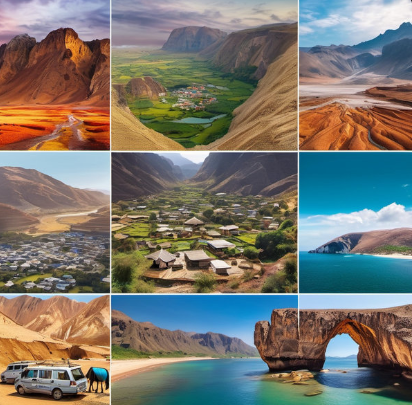Discover unique, off-the-beaten-path destinations offering unforgettable experiences, perfect for adventurous souls seeking something different.
Off-the-Beaten-Path Adventures
Travel enthusiasts often seek destinations that go beyond the ordinary, opting for experiences that allow them to connect with cultures, landscapes, and traditions authentically. While iconic landmarks and popular tourist spots remain appealing, venturing off the beaten path offers a rare opportunity to uncover hidden gems. These lesser-known destinations captivate the adventurous spirit with their charm, untouched beauty, and serenity.
This article explores ten destinations that promise an enriching journey for those willing to step off the conventional trail. Whether it’s a secluded desert, a historical treasure, or a natural wonder, these locations cater to every type of traveler seeking something unique.
1. Faroe Islands, Denmark: Rugged Beauty at Its Best
Located in the North Atlantic between Norway and Iceland, the Faroe Islands are an archipelago of unspoiled natural beauty. This destination remains one of the least crowded travel spots, offering breathtaking vistas and an unmatched sense of tranquility.
- Getting There: Accessible via flights from Copenhagen or Edinburgh, followed by ferry rides between islands, the journey itself is part of the adventure.
- Key Attractions:
- The iconic Mulafossur Waterfall in the village of Gásadalur, where water cascades directly into the ocean.
- Lake Sørvágsvatn, an optical illusion perched above the Atlantic, is a photographer’s dream.
- Local Culture: The Faroese are known for their hospitality and strong traditions in music and gastronomy. Festivals such as Ólavsøka offer insights into the island’s vibrant culture.
- Adventure Opportunities:
- Hiking trails like those on Mykines and Kalsoy provide dramatic views of the sea and mountains.
- Puffin watching on Mykines during the breeding season adds an element of wildlife appreciation.
2. Matera, Italy: A Journey Back in Time
Situated in the Basilicata region of southern Italy, Matera is renowned for its ancient cave dwellings called “Sassi,” which are believed to be among the first human settlements in Italy.
- Historical Significance: The Sassi, carved into limestone, were once homes, churches, and cisterns, preserving a history that dates back thousands of years.
- Modern Touches:
- Several caves have been repurposed into boutique hotels, offering visitors a chance to experience living history.
- Fine dining establishments in these caves serve regional specialties, blending tradition with innovation.
- Activities:
- Walking tours through the ancient city offer insights into its rich architecture.
- Exploring the Rupestrian Churches with frescoes is a must for art enthusiasts.
- Best Time to Visit: Late spring and early autumn when the weather is pleasant and the crowds are minimal.
3. Wadi Rum, Jordan: The Valley of the Moon
Known for its mesmerizing desert landscapes, Wadi Rum offers an extraordinary experience akin to stepping onto another planet. The vast expanse of red sand dunes, towering sandstone mountains, and ancient rock carvings make it an awe-inspiring destination.
- Cultural Encounters: The Bedouin tribes welcome visitors with traditional music, cuisine, and stories under starry skies, enriching the experience.
- Outdoor Activities:
- Camel trekking allows you to traverse the desert like the nomads of old.
- Sandboarding down towering dunes is an adrenaline-pumping activity.
- Stargazing under the pristine night sky offers a celestial spectacle.
- Film Connections: The stunning terrain has been a backdrop for films such as Lawrence of Arabia and The Martian.
4. Huacachina, Peru: A Desert Oasis
Huacachina, a tiny village built around a natural oasis in the middle of the Peruvian desert, is a true hidden gem.
- Sandboarding and Dune Buggy Rides: Adrenaline seekers flock here for the thrilling activities on the surrounding sand dunes.
- Local Legends: The lagoon is said to be home to a mythical mermaid, adding a layer of intrigue to the area.
- Accommodations: Options range from rustic hostels to luxurious desert resorts, catering to all budgets.
- Unique Experiences:
- Sunset tours of the dunes provide breathtaking views of the desert landscape.
- Kayaking in the oasis adds a refreshing twist to the adventure.
5. Svaneti, Georgia: A Hidden Alpine Paradise
Nestled in the Caucasus Mountains, Svaneti is a region of stunning natural beauty and rich cultural heritage.
- Ancient Watchtowers: These defensive structures, built during the Middle Ages, dominate the landscape and offer a glimpse into the region’s history.
- Hiking Trails:
- The Mestia to Ushguli trek is among the most popular, offering views of glaciers, valleys, and mountain peaks.
- Other trails lead to pristine lakes and scenic vantage points.
- Cuisine: Svaneti’s unique dishes like Kubdari (meat pie) and Chvishtari (cheese cornbread) showcase its culinary traditions.
- Festivals: Traditional Svan festivals, featuring music and dance, provide cultural immersion.
6. Socotra, Yemen: An Alien Landscape
Socotra Island is a treasure trove of biodiversity, often referred to as the “Galápagos of the Indian Ocean.”
- Flora and Fauna:
- The iconic Dragon’s Blood Tree, with its umbrella-like canopy, is a striking feature of the landscape.
- Unique species of birds and plants add to its ecological importance.
- Beaches and Caves:
- Pristine beaches offer opportunities for relaxation and snorkeling.
- Hoq Cave, with its stalactites and inscriptions, provides an adventurous escape.
- Sustainability: Efforts are being made to preserve the island’s delicate ecosystem, making it a model for ecotourism.
7. Luang Prabang, Laos: A Cultural Haven
This charming town in Laos is known for its blend of French colonial architecture and Buddhist heritage.
- Morning Almsgiving Ceremony: A serene ritual where locals offer food to monks, showcasing the town’s spiritual essence.
- Natural Wonders:
- Kuang Si Falls, a multi-tiered waterfall with turquoise pools, is a highlight.
- The Pak Ou Caves, filled with thousands of Buddha statues, offer a spiritual retreat.
- Night Markets: Visitors can sample local delicacies and purchase handcrafted items such as silk scarves and bamboo crafts.
8. Raja Ampat, Indonesia: Underwater Wonderland
Raja Ampat is a dream destination for marine life enthusiasts, boasting some of the richest biodiversity in the world.
- Snorkeling and Diving:
- Coral reefs teem with colorful fish, manta rays, and turtles.
- Dive sites like Cape Kri are renowned for their diversity.
- Eco-Friendly Lodging: Resorts in the region prioritize sustainability, ensuring minimal impact on the environment.
- Island Hopping: A journey through small, idyllic islands reveals hidden lagoons and secluded beaches.
9. Patagonia, Chile/Argentina: Untamed Wilderness
Patagonia’s dramatic landscapes offer a mix of glaciers, fjords, and mountains that stretch across two countries.
- Key Attractions:
- Torres del Paine National Park features iconic granite peaks and serene lakes.
- Los Glaciares National Park showcases the majestic Perito Moreno Glacier.
- Unique Wildlife: The region is home to guanacos, condors, and Magellanic penguins.
- Adventure Activities:
- Hiking trails like the W Trek are globally renowned.
- Kayaking in fjords and ice fields adds to the thrill.
10. Gjirokastër, Albania: A Stone City of Charm
Gjirokastër, known as the “City of Stone,” is a UNESCO World Heritage Site famed for its Ottoman-era architecture.
- Historical Landmarks:
- The Castle of Gjirokastër offers panoramic views and houses a military museum.
- The Ethnographic Museum, located in the former home of dictator Enver Hoxha, provides insights into traditional life.
- Local Crafts: Workshops offer handmade items like carpets, wooden utensils, and silver filigree jewelry.
- Cuisine: Traditional dishes such as qifqi and oshaf reflect the region’s culinary heritage.
Where to Book Flights to Remote Destinations
Planning a trip to lesser-known destinations requires careful consideration of travel logistics, particularly flights. Since these locations are often off the main tourist routes, direct flights may not always be available.
- Online Platforms for Flights:
- Skyscanner: Offers comparisons across airlines and routes, allowing travelers to find the best deals.
- Google Flights: Provides a user-friendly interface for exploring flexible dates and destinations.
- Kayak: Features price alerts to notify you when fares drop for your chosen route.
- Regional Airlines: Many remote locations, such as the Faroe Islands or Socotra, are served by regional carriers. For example:
- Atlantic Airways for the Faroe Islands.
- Yemenia Airlines for Socotra.
- Multi-City Itineraries: When traveling to remote destinations, booking a multi-city ticket can save time and money by combining layovers and stops strategically.
- Tips for Budget-Friendly Flights:
- Fly during the off-peak season to avoid inflated prices.
- Use airline miles or credit card points to reduce costs.
- Be flexible with travel dates and nearby airports for cheaper options.
Where to Book Hotels or Accommodations
Accommodations in off-the-beaten-path locations can range from luxury eco-lodges to family-run guesthouses. Finding the right place to stay is essential for ensuring a comfortable and immersive experience.
- Booking Platforms:
- Booking.com: Features options for all budgets, including boutique hotels and unique stays like cave accommodations in Matera.
- Airbnb: Ideal for finding homestays and private rentals, offering a local touch.
- Agoda: Particularly useful for destinations in Asia, such as Luang Prabang or Raja Ampat.
- Specialized Services:
- Hostelworld: For budget-conscious travelers seeking dormitories or affordable private rooms.
- Mr & Mrs Smith: A curated collection of boutique and luxury hotels for unique experiences.
- Local Recommendations: In regions like Svaneti or Gjirokastër, local tourism websites or community forums often provide insider tips on authentic accommodations.
- Sustainable Stays:
- Choose eco-lodges or resorts with sustainable practices, such as those in Raja Ampat or Patagonia.
- Look for certifications like Green Globe or EarthCheck.
- Travel Insurance Consideration: Some remote accommodations require upfront payments. Make sure your travel insurance covers cancellations to protect your investment.
Essential Tips for Planning Your Trip
Traveling to off-the-beaten-path destinations comes with unique challenges and opportunities. Proper planning ensures a smooth and enjoyable journey.
- Visa and Entry Requirements:
- Check visa requirements well in advance, as some destinations have specific regulations or longer processing times.
- For remote areas like Socotra or Wadi Rum, permits may be required for entry.
- Transportation at the Destination:
- Research local transport options, such as renting a car in the Faroe Islands or hiring a guide in Wadi Rum.
- Consider booking transfers or domestic flights if the destination is spread across multiple locations, like Raja Ampat.
- Packing Essentials:
- Lightweight, breathable clothing for warm destinations like Huacachina or Wadi Rum.
- Layers and waterproof gear for colder regions such as Patagonia or Svaneti.
- A first-aid kit, travel adapter, and portable charger are indispensable.
- Local Currency and Payments:
- Many remote areas may not accept credit cards, so carry sufficient cash in the local currency.
- Research exchange rates and avoid exchanging money at airports where rates are often less favorable.
- Health Precautions:
- Ensure vaccinations are up-to-date, particularly for tropical destinations like Socotra or Raja Ampat.
- Carry necessary medications and a basic medical kit.
- Cultural Sensitivity:
- Familiarize yourself with local customs and traditions to avoid unintentional disrespect.
- In regions with strong cultural or religious practices, such as Jordan or Laos, dress modestly and follow local etiquette.
Navigating Local Experiences and Tours
To truly immerse yourself in off-the-beaten-path destinations, participating in local experiences and guided tours is invaluable. These activities not only enhance your trip but also support local communities.
- Finding Local Tours:
- GetYourGuide and Viator: These platforms offer curated tours in remote destinations, often with local guides.
- Local tourism offices or community-run websites often list unique tours not found on global platforms.
- Cultural Experiences:
- Faroe Islands: Join a traditional Faroese knitting workshop or fishing trip.
- Luang Prabang: Participate in a cooking class to learn about Lao cuisine.
- Svaneti: Attend a traditional Svan dance performance or explore watchtower villages with a local guide.
- Adventure Activities:
- Wadi Rum: Explore the desert on camelback or by Jeep with Bedouin guides.
- Patagonia: Book guided treks, such as the W Trek, to ensure safe navigation of the rugged terrain.
- Wildlife Encounters:
- In Raja Ampat, hire a local guide for snorkeling tours that adhere to conservation principles.
- In Socotra, expert-led tours can help you explore biodiversity hotspots responsibly.
- Customized Private Tours: For destinations with limited tourist infrastructure, private tours can be arranged to fit specific interests, such as photography, history, or nature exploration.
Digital Tools and Apps for Off-the-Beaten-Path Travel
Technology has become an indispensable tool for modern travelers, even in remote destinations. Equipping yourself with the right apps and digital tools can simplify logistics and enhance your journey.
- Navigation and Maps:
- Google Maps: Useful for offline maps in destinations like Gjirokastër or Matera. Download maps beforehand for areas with limited connectivity.
- Maps.me: Known for its detailed offline maps, perfect for hiking trails in Svaneti or Patagonia.
- Translation Apps:
- Google Translate: A lifesaver in places where English is not widely spoken, such as Socotra or Laos.
- Add regional language packs for offline use.
- Currency Conversion:
- XE Currency: Provides real-time exchange rates and offline access to calculations.
- Weather Forecasts:
- AccuWeather: Keep track of weather conditions, especially important for destinations with unpredictable climates like the Faroe Islands.
- Booking and Planning:
- TripIt: Consolidates flight, hotel, and activity bookings into a single itinerary.
- Rome2Rio: Offers comprehensive travel route options, including buses, ferries, and trains.
- Emergency Contacts and Safety:
- Save the contact details for local emergency services and your country’s embassy in a secure app like Evernote.
- bSafe: A personal safety app that allows location sharing and emergency alerts.
- Sustainable Travel Apps:
- HappyCow: Guides you to vegan and vegetarian dining options in even the most remote places.
- Good On You: Rates the sustainability of brands, useful for responsible shopping.
FAQs
Q1: What defines an off-the-beaten-path destination?
A: These destinations are less frequented, offering unique, peaceful experiences away from crowded tourist hubs.
Q2: How do I prepare for travel to remote locations?
A: Research travel requirements, pack essentials, and ensure safety by staying informed about local customs and weather conditions.
Q3: Are these destinations suitable for families?
A: Many of these locations are family-friendly, but some activities may require consideration for younger children or elderly members.
Q4: What’s the best way to immerse in local cultures?
A: Engage with locals, participate in traditional activities, and respect customs and practices.
Q5: How can travelers minimize their ecological footprint?
A: Use eco-friendly accommodations, support local initiatives, and avoid disturbing wildlife.
Safe travels !!!












